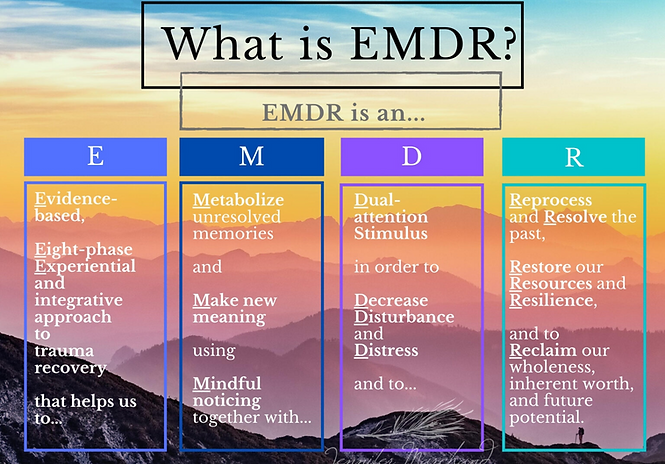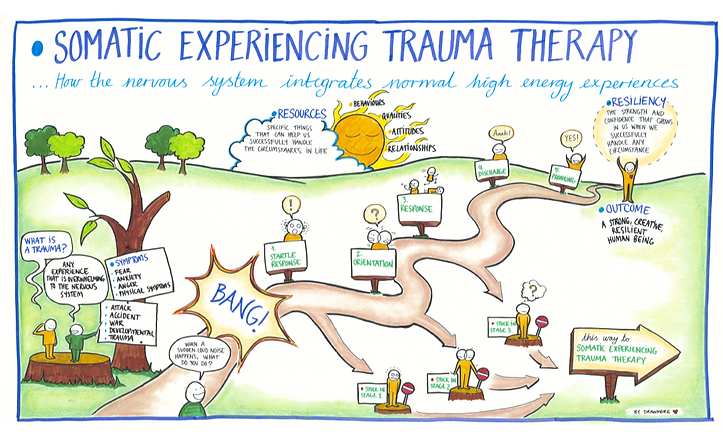TRUE INHERITANCE THERAPY


What is EMDR?
Eye Movement Desensitization and Reprocessing (EMDR) is a type of trauma therapy that accesses the natural healing centers in the brain. These healing centers can be used intentionally through bilateral stimulation to desensitize and reorganize information that gets “stuck” in the nervous system during trauma and eventually results in triggers. This type of therapy can help to decrease or even eliminate common mental health issues such as panic attacks, flashbacks, obsessive thinking, hopelessness, sexual shame, self-hate, dissociation, unhealthy attachment styles, defensiveness, anger and low self-esteem to name a few. EMDR Therapy can be utilized through Telehealth/Virtual appointments as well!
Who might benefit from EMDR?
EMDR can be supportive for people who are:
-
Survivors of trauma or PTSD (such as accidents, assaults, abuse, or combat)
-
Individuals with childhood trauma or attachment wounds
-
People struggling with anxiety, panic attacks, or phobias
-
Those experiencing depression linked to unresolved experiences
-
Individuals carrying grief or complicated loss
-
People dealing with low self-esteem, shame, or negative self-beliefs
-
Survivors of domestic violence or relationship trauma
-
First responders, medical professionals, or caregivers facing secondary trauma or burnout
-
Individuals with chronic stress or somatic symptoms connected to emotional pain
What might an EMDR session look like?
An EMDR session is a safe, guided process designed to help your brain reprocess distressing memories so they no longer feel overwhelming. Sessions may include:
Getting Grounded: We begin by checking in, building a sense of safety, and practicing calming or grounding techniques.
Identifying the Target: Together, we choose a memory, belief, or feeling that feels important to work on.
Bilateral Stimulation: While focusing on the memory, you’ll engage in gentle left–right stimulation (such as eye movements, tapping, or sounds). This helps the brain “re-file” the memory in a more adaptive way.
Processing: As the memory shifts, new insights, emotions, or body sensations may arise. I’ll guide and support you throughout so you’re never alone in the process.
Closing the Session: We end by ensuring you feel grounded, calm, and safe. You’ll leave with tools for ongoing stability and self-care.
Over time, the memory itself doesn’t disappear—but the intensity, emotional charge, and stuckness around it lessens, allowing space for healing, resilience, and new perspectives.
_edited_edited_p.png)
What is SE?
Somatic Experiencing (SE) is a body-based approach to healing trauma and stress. Instead of only talking about difficult experiences, SE gently guides you to notice physical sensations, emotions, and impulses in the body. By slowing down and paying attention to these signals, your nervous system learns to release tension, complete “stuck” survival responses, and return to balance.
This process helps reduce symptoms of trauma—such as anxiety, hypervigilance, dissociation, or feeling “frozen”—and supports greater resilience, calm, and connection.
In simple terms: SE helps your body let go of the stress and trauma it’s been holding onto, so you can feel safer, more grounded, and more alive.
Who might benefit from SE?
Somatic Experiencing can be supportive for people who are:
-
Living with trauma or PTSD (from accidents, abuse, violence, or medical events)
-
Experiencing anxiety, panic, or chronic stress
-
Struggling with dissociation, numbness, or feeling “shut down”
-
Coping with grief, loss, or major life transitions
-
Carrying the impact of childhood trauma or attachment wounds
-
Dealing with chronic pain, tension, or other body-based symptoms connected to stress
-
Survivors of natural disasters or sudden accidents
-
First responders, caregivers, or healthcare workers facing burnout or secondary trauma
-
Longing to feel more grounded and at ease in your body
In short: anyone who feels their body is holding onto stress, fear, or trauma—even after the event has passed—may benefit from SE.
What might a SE session look like?
A Somatic Experiencing (SE) session is gentle and guided, focused on helping your nervous system release stress and restore balance. Sessions may include:
Settling In: We begin by creating a sense of safety and slowing down.
Tuning Into the Body: With support, you’ll notice body sensations, emotions, or impulses connected to stress or past experiences.
Pendulation: We move gently between areas of tension and areas of ease, allowing the body to process what’s been held inside without becoming overwhelmed.
Releasing & Integration: As your body completes “stuck” stress responses, you may feel more relaxation, warmth, or flow.
Closing: We finish with grounding practices so you leave feeling safe, steady, and connected.
Rather than reliving trauma, SE helps your body gradually let go of it—so you can feel calmer, more present, and more at home in yourself.